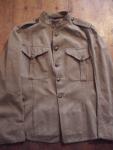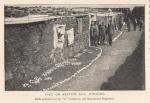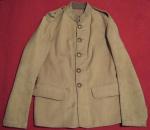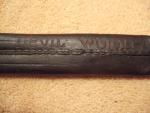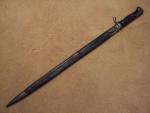
William1
Past Contributor-
Posts
89 -
Joined
-
Last visited
Content Type
Profiles
Forums
Blogs
Gallery
Events
Store
Everything posted by William1
-
Boer War Tunic
William1 replied to fallschirmjager's topic in Great Britain: Militaria: Badges, Uniforms & Equipment
Mike This appears to be the pattern commonly worn by the Imperial Yeomanry. The infantry usually wore either the two-pocket serge, as in my Boer War serge topic, or the khaki drill pattern. I no longer have one of these, but here is a photo. Regards, W. -
Home Service Helmet
William1 replied to paul w's topic in Great Britain: Militaria: Badges, Uniforms & Equipment
Whatever it is, it clearly originally had different types of fittings, most notably the spike base, as has been pointed out. Stuart - the sweatband looks to have similar cork spacers to the foreign service helmet I used to own and which I posted pictures of recently. Regards, W. -
Boer War serge jacket
William1 replied to William1's topic in Great Britain: Militaria: Badges, Uniforms & Equipment
Tony Yes, that is one of the two pattern variants of KD worn in the Boer War. KD wasn't completely replaced by serge and was worn throughout the war, but much less commonly after early 1900. The slouch hat wasn't worn in India, and with the KD jacket it says Boer War to me. Do you know which unit he served with? Regards, W. Add: That looks a very British scene! I would say he is wearing a jumper under that, wouldn't you? And I see there are what look like infantry shoulder titles on the jacket, and perhaps regimental buttons. -
Boer War serge jacket
William1 replied to William1's topic in Great Britain: Militaria: Badges, Uniforms & Equipment
Here is a summary of the activities of the battalion in South Africa. From http://www.tameside....history/militia "Following the outbreak of the Anglo Boer War in 1899 two additional Line Battalions were raised and numbered 3rd and 4th Battalions. Accordingly on 1 March 1900 the two Militia Battalions were renumbered 5th and 6th Battalions. Both volunteered for service in South Africa. The 5th Battalion was embodied on 3 May 1900 and sent to Aldershot where it remained until 19 October when it returned to Ashton under Lyne and was disembodied. However from the commencement of the war drafts were sent to both the 1st and 2nd Battalions in South Africa. In May 1901 the 5th Battalion was again mobilised and returned to Aldershot where it was soon under orders to proceed to South Africa. Sir Redvers Buller, who complimented it on its efficiency, inspected the battalion at Aldershot. On 17 June 1901 the battalion embarked from Southampton on the Bavarian. On the voyage the battalion changed from their scarlet uniforms to khaki and all their equipment such as the black valise etc was exchanged for web equipment on arrival at Cape Town on 10 July 1901. During the voyage everyone was inoculated against enteric fever, resulting in most people being ill for at least two days. After disembarkation they proceeded to Winburg, Orange River Colony where they were employed on the defence of the town and the railway towards Smaldeel. A, B, C, D, G and H Companies were employed in the defence of the town whilst E Company was on the railway. By this time in the war the fighting had developed into mainly guerrilla warfare and the chief object of the defence was to prevent parties of the Boers from breaking through whilst flying columns tried to round them up. Attempts were made to break through the defences but were repulsed with the loss by the battalion of one man killed, one died from wounds and four others wounded. On 8 April 1902 the battalion moved to relieve the 4th Cheshire Regiment and took over the defences of the railway line towards Kroonstadt with D Company being sent to Brandfort. The battalion remained in the Smaldeel area until peace was declared on 31 May 1902 and on 9 July the battalion embarked at Capetown on the SS Briton and sailed for England. They arrived back at the Depot in Ashton under Lyne on 31 July 1902 and disembodied that same day." From the casualty list of the South African Field Force: 7200 Pte J Corcoran killed, Smaldeel, 17 July 1901 7322 Pte J Bowler severely wounded, Smaldeel, 8 August 1901 5758 Pte S Shaw severely wounded, Smaldeel, 8 August 1901 Lieut. E B W Solano prisoner (released), nr Dundee, 17 September 1901 (detached?) 7599 Pte J Brennan severely wounded, Winburg, 14 October 1901 7172 Pte E D Aspinall accidentally wounded, Winburg, 1 December 1901 6670 Pte F Wood accidentally wounded, Brandfort, 2 May 1902. 18 men died of disease (+ 1 officer attached SAC). -
Boer War serge jacket
William1 replied to William1's topic in Great Britain: Militaria: Badges, Uniforms & Equipment
Here are C Company of the 5th Manchesters in South Africa. From After Pretoria, p. 810. Some have slouch hats, some have the blue undress cap. The two men with rifles appear to have webbing bandoliers. -
Boer War serge jacket
William1 replied to William1's topic in Great Britain: Militaria: Badges, Uniforms & Equipment
Yes, buttons and titles in brass, also belt hooks. The buttons are by Smith and Wright. The jacket is well and truly beat-up and has faded to a mustard colour which doesn't really come over here. I never found a plain period slouch hat to put with it - didn't really want one of the big batch with 4 badge holes that still turn up now and again, so if anyone has one they could spare, I'd be very pleased to hear from them! -
Victorian ID card/tag ?
William1 replied to Tony's topic in Great Britain: Militaria: Badges, Uniforms & Equipment
Tony I don't know what this is - it may be an unofficial ID card. The official version used in the Boer War was called the "description card", and was printed on linen and sewn into an interior jacket pocket - see my Boer War serge topic. IIRC there were lines for name number and corps; can't be sure (even though I used to own one) but there is a picture somewhere in one of the With the Flag to Pretoria volumes. Regards, W. -
I don't know anything about Canadian uniforms so can't comment on what should be on this. But whatever it is is clearly an early piece. From the hand stitching and the look generally I would have said 1870s-1880s, which fits with the date range for this unit. We all know how rare kit of this age is, so unless it was a horrendously expensive piece, personally I'd hang onto it. A good thing, one way or another.
-
Boer War serge jacket
William1 replied to William1's topic in Great Britain: Militaria: Badges, Uniforms & Equipment
-
I thought fellow members would like to see one of these, as they seldom turn up. This pattern was approved for use in South Africa in 1899, and by mid-1900 most of the regular army was using it, though the khaki drill continued in service in a minor way on LOCs, blockhouse garrisons etc. It is in effect a copy in khaki of the red undress frock. Note the two inner skirt pockets, one for the field dressing and one for the description card, forerunner of the ID disc. This belonged to a private in the 5th (militia) Bn Manchester Regt. Unfortunately the number stamped inside the button closure is not fully readable - it is 4**8. 5 Man is visible above the number. This unit was stationed in and around Winburg and Smaldeel in the Free State from 1901-1902, and whilst seeing no major actions, it was evidently involved in the occasional smallscale local engagement, with casualties in action of 1 killed and 3 wounded. Other than a Boer War helmet cover, this is the last remaining piece from my Boer War collection. I particularly like the fading and the heavy wear. It looks as if he has had cartridges in his pockets! There is a photo of men from this unit in After Pretoria - the Guerilla War, showing them with slouch hats and web bandoliers.
-
Tony, that Lifeguard periscope of yours is - by far - the finest example I have seen in 30 years of collecting. I would think the cleaning cloth is probably original to it, not that I have seen one of them before, and I must have seen dozens of the periscopes. Very nice. I will have to dig out my No. 26 periscope and take some photos. It's the model with the wiggly wire bit welded to the top for attaching bits of camouflage rag etc. It came in a canvas case, which is a bit ill-fitting but seems to belong to it. I also have a "Vigilant" bayonet mirror named to an Argyll and Sutherland Highlander who was killed on the Somme. Nothing spectacular to look at, but a poignant piece. Regards, W.
-
Mervyn Thank you, and "William" will do fine! We don't know each other, in fact I don't know any collectors or dealers in SA. But I'll be pleased to help out with any information I can. I now collect only WW1 British items, but I maintain an interest in the 2nd Boer War, and specifically the Imperial Yeomanry in SA. Best wishes, W.
-
Hi Stuart I doubt I know any more than you do about helmet construction, and I was quite surprised when I got the cover off the Sea Hrs to find a 4-piece body underneath, an X rather than a + as you look down on it, unlike the cover. I'd expected 6 seams. There was also a thick white puggaree. The trouble is that these helmets are so rare you don't see enough to form an opinion of how they are usually constructed. As regards Paget's Horse, there are two books on their first contingent, which I imagine is the one relevant to your helmet: "With Paget's Horse to the Front" by Cosmo Rose-Innes, which is a bit disconnected but the only proper history of PH, and "The Cossack Post", no author, a sort of humorous journal of "B" Squadron, the 52nd company, which contains some good info but is annoyingly vague and only essential for the serious student of PH. I'm lucky in that my copy has all their names handwritten inside the front cover. Re the Omdurman flash, yes I do mean the flashes for the Sudan campaign. I don't have the details of these handy, but the G Guards one was something like a red circle with a short blue tag hanging from the centre. The flash wasn't taken into the Boer War. It was specific to the 1st Bn, which didn't serve in SA. Finally, as you possibly know, Alan Beadle has had some outstanding kit, but I've also seen him with quite a few old dogs (I am talking about military collectables here), so as with many dealers it's caveat emptor. In my experience, if they think you know your stuff then they will respect you and treat you accordingly, but if they think they can milk you then they will do so mercilessly. Just my view. Best wishes, W.
-
This was the property of Private Caslin, of the 1st Volunteer Company. The company history is quite superb, and has a picture of him. Apparently he was their champion boxer. No idea where this one is now, but in some ways it was the nicest one I've owned, though the Magersfontein helmet was pretty good too. If memory is correct that one belonged to Pte. Arthur Lott.
-
Alex Just adding my appreciation to a truly OUTSTANDING set of photo albums. Rawlinson is I presume the same general who masterminded the early phase of the Somme in 1916. It is certainly a valuable, and quite historically important, set. IY is definitely Imperial Yeomanry btw, and is there perhaps a note of amusement at their greenness in the caption? Interesting too to see so many early "pointy" Wolseley helmets being worn by the officers. Somewhere out there are the descendants of those men. I imagine they would be quite thrilled to see those photos. Regards, W.
-
Hello Mervyn In my Boer War collecting days, I owned a "hyposcope" similar to this, except that it was painted khaki and had quaint instructions on "observing from behind "cover"". It was obviously meant for service use, except that it would have been pretty useless as it was only about eight inches long. Unfortunately I haven't kept a photo, but I think the date 1900 was on it somewhere (can't be 100% sure as this was a good 15 years ago, but I recall having a sound reason for keeping it in my Boer War collection). I collect WW1 British kit and have several periscopes of the period; this one clearly was not. Regards, W.
-
Hi Stuart Thanks for the welcome. Yes, I sold Chris the helmet when I broke up my Boer War collection. I can't remember what he gave me for it but it was a long time ago, and I don't begrudge Chris his profit, as it is his living after all! Plus C is one of the very few dealers I trust. I have some photos of the other helmets somewhere, pre-digital and not on my PC. I will try to find them and scan them in at some point. The Sea Hrs one was plain, no flash but nicely named and dated, 4-piece white helmet w. 4-piece cover. It was only the second one I've ever seen, the first being a Grenadier Guards' CSM, I think, dated 1897, with the Omdurman flash and clearly dead right. I wonder where that is now?! It was with a dealer called Alan Beadle. The sweatband was a bit eaten away, but it was still a remarkable piece. The Rietfontein casualty helmet was the white wicker pattern and I did not have a cover for it. I eventually found a 6-piece one that just about fitted, but never found the correct Indian cover with the wide band. I haven't seen anything in Collectors' Corner yet because I haven't yet got access to that forum. Best wishes, W.

